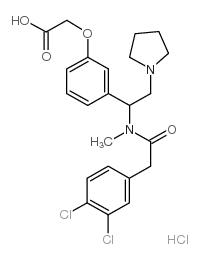Kappa opioid agonist-induced changes in IOP: correlation with 3H-NE release and cAMP accumulation.
T T Moore, D E Potter
Index: Exp. Eye Res. 73(2) , 167-78, (2001)
Full Text: HTML
Abstract
Opioid receptors have been demonstrated to modulate various functions in the eye. This research project was designed to determine and compare the effects of kappa opioid agonists on selected parameters that influence ocular hydrodynamics. Experiments determined the effects of two relatively selective kappa opioid receptor agonists, ICI 204 448 (ICI), which has limited ability to penetrate the blood-brain barrier, and spiradoline mesylate on: (1) in vivo parameters, intraocular pressure (IOP) and pupil diameter (PD); and (2) in vitro parameters, neurotransmitter release and cAMP accumulation, in the ciliary body. Dark-adapted, reverse light cycle New Zealand white (NZW) male rabbits were used in all experiments. In in vivo experiments, intraocular pressures and pupil diameters were measured by a pneumatonometer and an optistick, respectively, before and after drug administration. Baseline readings were taken at 0.5 and 0 hr prior to agonist administration. Postdrug IOP and PD measurements were made at 0.5, 1, 2, 3, 4 and 5 hr after agonist application. In some experiments, the relatively selective kappa antagonist, norbinaltorphimine was applied 30 min prior to agonist application. In in vitro experiments, the release of tritiated norepinephrine (3H-NE) was measured from perfused electrically stimulated iris ciliary bodies and expressed as the percent change of the control. Basal and isoproterenol-stimulated cyclic AMP concentrations in iris ciliary bodies were quantified by radioimmunoassay techniques in the presence and absence of ICI and spiradoline. ICI and spiradoline decreased IOP in a dose-dependent manner in normal rabbits, but only spiradoline produced significant changes in PD. The kappa opioid receptor antagonist, norbinaltorphimine, antagonized the hypotensive effects of spiradoline and ICI in IOP experiments. Both kappa agonists inhibited the release of norepinephrine from perfused iris ciliary bodies. Isoproterenol- stimulated cAMP levels in iris ciliary bodies were suppressed by both kappa receptor agonists. The antagonism by norbinaltorphimine suggests that ICI and spiradoline lower IOP by activating kappa opioid receptors in the eye. The bilateral effects of unilaterally applied spiradoline on PD indicate that this kappa agonist activates receptors in the iris and/or the brain. The inhibition of norepinephrine release and cAMP accumulation in the iris ciliary body by ICI and spiradoline suggests that there are both pre- and postjunctional sites of action for kappa agonists.Copyright 2001 Academic Press.
Related Compounds
| Structure | Name/CAS No. | Molecular Formula | Articles |
|---|---|---|---|
 |
ICI 204,448 hydrochloride
CAS:121264-04-8 |
C23H27Cl3N2O4 |
|
Teleantagonism: A pharmacodynamic property of the primary no...
2008-12-09 [Proc. Natl. Acad. Sci. U. S. A. 105(49) , 19038-43, (2008)] |
|
Effects of peripherally restricted κ opioid receptor agonist...
2012-03-01 [J. Pharmacol. Exp. Ther. 340(3) , 501-9, (2012)] |
|
Peripheral kappa-opioid agonist, ICI 204448, evokes hypother...
2005-05-01 [Pharmacology 74(2) , 79-83, (2005)] |
|
ICI 204448: a kappa-opioid agonist with limited access to th...
1989-04-01 [Br. J. Pharmacol. 96 , 986-992, (1989)] |
|
Antinociceptive effect of a kappa-opioid receptor agonist th...
1995-04-24 [Eur. J. Pharmacol. 277 , 275-280, (1995)] |